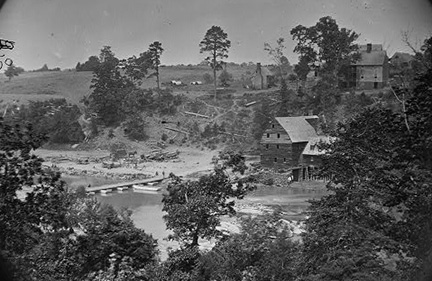“One of those incidents characteristic of war,” along the North Anna
 I’ve been finalizing this week the much-delayed updates to Strike Them a Blow: Battle Along the North Anna River. (Finally! You’re welcome to read about my woes with the book here.)
I’ve been finalizing this week the much-delayed updates to Strike Them a Blow: Battle Along the North Anna River. (Finally! You’re welcome to read about my woes with the book here.)
“The North Anna is an exceedingly picturesque river, abounding in beautiful scenery,” wrote Alexander Gardner in his Photographic Sketchbook; “the old mills of Jericho being not the least remarkable among its many attractions.” His photograph of the mill complex is fascinating.
After quickly recapping the action along the North Anna, Gardner concluded his entry with what he called “[o]ne of those incidents characteristic of war, and which can hardly be prevented, when an army marches through hostile countries. . . .”
Before the pontoon bridges were removed, some straggling soldiers entered one of the houses on the top of the bank, over the mill, and fired it, forcing the inmates to leave and seek refuge in the open air, where a heavy rain drenched them to the skin. They descended the hill, and crossed the pontoon bridge, a pitiful procession of women and wailing children, ignorant of the fact that the house they were seeking for protection was likewise destroyed and the inmates driven off.
In fact, two houses stood atop the plateau where the refugees were headed, both owned by the Fontaine family, which had connections back to Patrick Henry. It’s unclear which house Gardner was referring to, although at least one of them survived the battle and still stands, occupied.
Richmond National Battlefield now owns pretty much all of the Jericho Mills battlefield thanks to the American Battlefield Trust, which has done some incredible preservation work along the North Anna since I first wrote Strike Them a Blow in 2015. I’m glad to finally incorporate those new additions into the book.
Not only has the Trust preserved vital battlefield property, but they’ve preserved sites that now help tell some of the civilian stories of North Anna, too, including Jericho Mills, the Fontaine house sites, and the Fox house along Route 1.
They are important reminders of the human cost of war.
When I visited North Anna years ago, I recall that there was a small state park, with little done by way of interpretation. I look forward to a new visit to see the important preservation work of ABT.
The next time someone robotically cites the Union’s adoption of the Lieber Code as prima facie evidence of their embracing proportionally in warfare, uniquely tender souls that they were, this incident is just another to add to the contrarian data bank. It was a hard war, and getting consistently harder as it went along.
Check “Marbles and Civil War Prison Art” @ http://marblesecret.com/